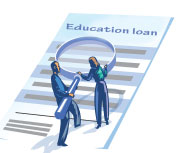Plotting the safest route to Education Loans

During the announcement of the interim budget for 2014-15 the Union Finance Minister P. Chidambaram declared a moratorium period for all the education loans that had been taken up to March 31, 2009 and are outstanding as of March 31, 2013. Although, this news pleased the 9 lakh students who had taken the education loans; the students who are planning to take the loans now appear to be more than worried. The reason for this worry is due to the fact that they are unsure whether they will receive the same kind of support from the government in case the value of the rupee drops down to an even lower point and also if the economic conditions change from bad to worse. Keeping this mind and ensuring that they do not go into debt, students and their families need to consider several points before applying for an educational loan which will help ease their worries.
1. Being Credit Worthy
What most students should understand is that since an educational loan is like any other commercial credit, it is at the bank�s discretion to sanction a loan after assessing the credit worthiness� of the borrower. As students generally do not have any credit history, banks insist that parents who are joint borrowers should also have a clear credit history.
2. Always beware of the Interest Rates
Most students and the parents fail to be aware of the interest rates charged on the education loans. As the interest rate is the primary method for banks to earn back the money, it is important that students and the parents must look at the variety of interest rates offered across various banks and choose the best one that fits them.
It is also important to note that for the benefit of Economically Weaker Sections also known as EWS or families with income less than Rs 4.5 lakhs, the central government has set up a scheme which provides full interest subsidy during the period of moratorium on loans taken by students from the banks. They can pursue any of the approved courses in technical and professional streams from recognized institutions.
3. Academic progress is also taken into account
Most banks monitor the academic progress of the students as it is necessary for them to ensure the asset quality of loans. While students may fail in one or two subjects, it is advised that they should be able to maintain a certain level of academic progress throughout the course of study.
4. Process to Pay Back the Loan
Despite the fact that the banks defer repayments; they start charging the interest immediately after the disbursal of the loan. By carefully enquiring whether it is charged on a daily reducing balance, or on a quarterly reducing balance, students and parents can make the payments during the moratorium period. To avoid the interest rates charged on loans which will keep on accumulating until the start of the repayments, it is advised to take up the option provided by the bank to pay the interest portion of the education loan immediately.
5. Be clear on the collateral and the fees
The fees associated with the education loan such as processing fees, administrative fees, documentation costs and others should be minimal. If students and parents are not careful, they may end up losing a lot of money. They must also be clear on the collateral, guarantee or security which is another key point. If a student applies for a loan that exceeds a value of Rs. 4 lakhs, then he/she has to provide collateral which may be anything from real estate properties to jewellery and others.
6. The down payment
What most people are not aware of is that they need to provide the bank a down payment in order for the bank to grant them the loan. The down payment which ranges between 5 � 20 percent of the loan amount has to be paid to the bank.
Although it is advised that students and parents should compare interest rates, various fees, collateral and down payment requirements across various banks; they should also be vigilant about the employability after the completion of the courses before taking up the burden of repaying credit. It is also widely suggested that students should pay their EMI on time to avoid high penal interest and should also be vigilant while servicing loans as sometimes banks keep on levying the penal charges even after the default has been made good. Therefore the best mantra that students can follow is to pay on time.
1. Being Credit Worthy
What most students should understand is that since an educational loan is like any other commercial credit, it is at the bank�s discretion to sanction a loan after assessing the credit worthiness� of the borrower. As students generally do not have any credit history, banks insist that parents who are joint borrowers should also have a clear credit history.
2. Always beware of the Interest Rates
Most students and the parents fail to be aware of the interest rates charged on the education loans. As the interest rate is the primary method for banks to earn back the money, it is important that students and the parents must look at the variety of interest rates offered across various banks and choose the best one that fits them.
It is also important to note that for the benefit of Economically Weaker Sections also known as EWS or families with income less than Rs 4.5 lakhs, the central government has set up a scheme which provides full interest subsidy during the period of moratorium on loans taken by students from the banks. They can pursue any of the approved courses in technical and professional streams from recognized institutions.
3. Academic progress is also taken into account
Most banks monitor the academic progress of the students as it is necessary for them to ensure the asset quality of loans. While students may fail in one or two subjects, it is advised that they should be able to maintain a certain level of academic progress throughout the course of study.
4. Process to Pay Back the Loan
Despite the fact that the banks defer repayments; they start charging the interest immediately after the disbursal of the loan. By carefully enquiring whether it is charged on a daily reducing balance, or on a quarterly reducing balance, students and parents can make the payments during the moratorium period. To avoid the interest rates charged on loans which will keep on accumulating until the start of the repayments, it is advised to take up the option provided by the bank to pay the interest portion of the education loan immediately.
5. Be clear on the collateral and the fees
The fees associated with the education loan such as processing fees, administrative fees, documentation costs and others should be minimal. If students and parents are not careful, they may end up losing a lot of money. They must also be clear on the collateral, guarantee or security which is another key point. If a student applies for a loan that exceeds a value of Rs. 4 lakhs, then he/she has to provide collateral which may be anything from real estate properties to jewellery and others.
6. The down payment
What most people are not aware of is that they need to provide the bank a down payment in order for the bank to grant them the loan. The down payment which ranges between 5 � 20 percent of the loan amount has to be paid to the bank.
Although it is advised that students and parents should compare interest rates, various fees, collateral and down payment requirements across various banks; they should also be vigilant about the employability after the completion of the courses before taking up the burden of repaying credit. It is also widely suggested that students should pay their EMI on time to avoid high penal interest and should also be vigilant while servicing loans as sometimes banks keep on levying the penal charges even after the default has been made good. Therefore the best mantra that students can follow is to pay on time.

